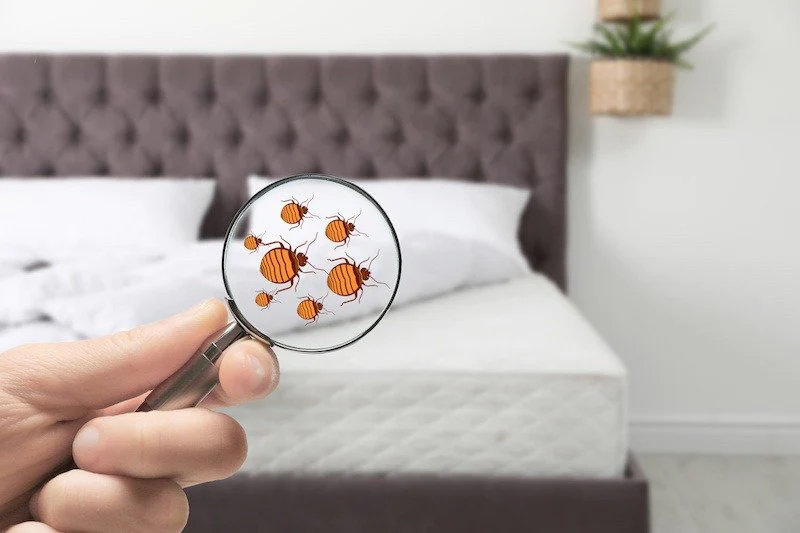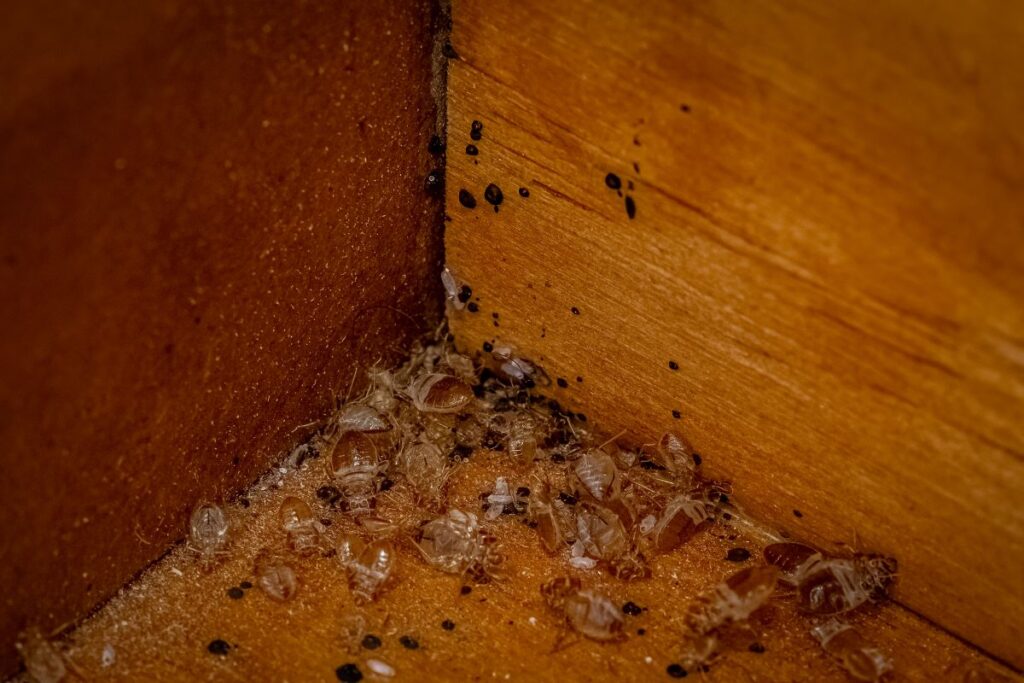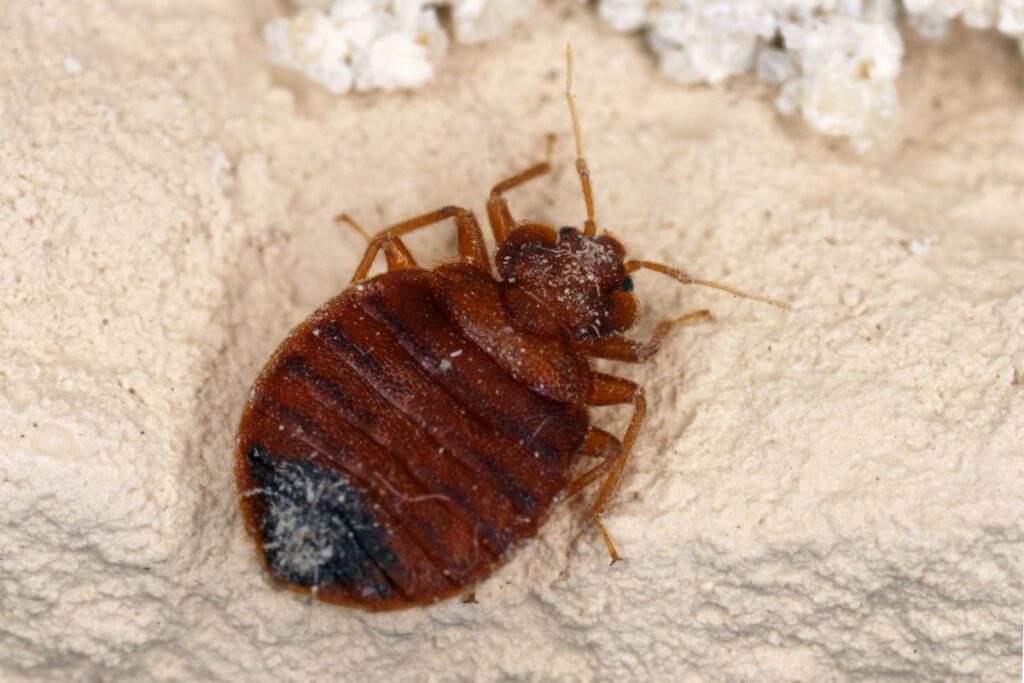The arrival of bed bugs in a home is often associated with a lack of hygiene. This is simply not true! Where do these pests really come from? What are the risk factors for infestation? And what are the best practices for preventing them? Find out in this article.
What causes an infestation?
Cause n°1 : Someone brings bed bugs into your home
This is one of the most common causes of infestation. It can happen when a guest, relative or even a professional, such as a mover or technician, visits your home after having been in contact with infested premises. Bed bugs can hide in clothes, shoes, bags or suitcases without the person concerned noticing. When it’s quiet, they come out to hide in furniture, skirting boards and other hiding places.
Practical prevention tips
- When receiving visitors, ask them to deposit their luggage in a tiled area (avoid the bedroom or living room) and visually inspect their belongings, especially if they have just returned from a trip.
- If in doubt, isolate their clothes and suitcases in an airtight plastic bag or other closed container. Tell them to wash their belongings at 60°C.


Cause n°2 : Moving into an infested apartment or building
It’s quite possible to move into a dwelling already infested by these pests, either because previous tenants didn’t deal with the problem, or because bed bugs have spread from a neighboring apartment.
These pests can travel through walls, air ducts, cracks or baseboards, infesting several units in the same building.
By bringing your furniture and belongings into an infested apartment, you run the risk of contaminating your personal possessions. Bed bugs can then hide in your bedding, clothes or furniture, making the infestation even harder to eradicate.
Practical prevention tips
- Before you move in, ask your landlord or real estate agent about the history of bed bugs in your home. Don’t hesitate to ask about previous infestations and treatments.
- During the visit, carefully inspect the rooms, especially the bedrooms, for signs of infestation such as black spots on baseboards, mattresses or walls.
- In some cases, the presence of bed bugs may be hidden by the sellers. If you have any doubts, you can call in a dog detection professional. It’s an effective method.
Cause no. 3: Increased travel
In 2023, there were 448 million overnight stays booked on Airbnb worldwide (source) and 1,049 million on Booking.com (source).
Travel is one of the main causes of the spread of bed bugs. Whether you’re staying in a hotel, renting a vacation property, or traveling on business, bed bugs can easily hide in your luggage and clothing. Hotel rooms, especially busy ones, are often hot spots for these insects.
The rise in international travel in recent years has also contributed to the resurgence of bed bugs, as they are often transported from one country to another, regardless of climate or season.
And beware of huts when hiking!
Practical prevention tips
- When staying in a hotel or rental, inspect bedding and furniture for signs of bed bugs (black spots, bloodstains, or small insects).
- If in doubt, you can use our bed bug repellent Shield Spray as a preventive measure.
- Keep your luggage on a raised support rather than on the floor or bed, and avoid storing your clothes in drawers.
- When you return, wash your clothes at high temperature (60°C minimum) and vacuum your luggage.


Cause n°4 : Buying second-hand items
Leboncoin, Vinted, etc. – second-hand furniture is very popular with consumers.
However, buying second-hand furniture or objects is a risk factor for bed bugs infestation. Bed bugs can easily hide undetected in mattress seams, sofa nooks and crannies, furniture drawers or even second-hand textiles.
Unfortunately, items offered on online sites, at garage sales, flea markets or second-hand markets are rarely inspected before sale.
Practical prevention tips
- Inspect carefully before buying second-hand;
- Check the seams of mattresses and sofas, and the crevices of wooden furniture for signs of infestation (black spots, small dead skins or insects).
- If in doubt, steam furniture at high temperature and wash textiles at 60°C before bringing them into your home;
- Avoid picking up items left on the sidewalk, even if they appear to be in good condition.
Cause n°5 : Public transport
Buses, trains and subways are another means by which bed bugs can spread rapidly. These insects hide in upholstered seats, cracks in carriages or buses, and can pass from one passenger to another, attaching themselves to clothing or bags.
A recent example of the psychosis surrounding bed bugs occurred in the run-up to the Paris Olympics in 2024. The media reported testimonies from metro and train passengers claiming to have seen bed bugs on Parisian public transport. This concern created a real panic, prompting many people to avoid certain journeys or take precautionary measures, such as not sitting in the carriages.
Practical prevention tips
- Try to limit direct contact with seats and textile surfaces, especially if you notice signs of infestation (black spots or visible insects).
- Use SHIELD Bed Bug Repellent by applying it to areas of contact with seats and luggage.
- After a journey, inspect your clothes and bags to make sure no bedbugs have latched onto them.
- Wash your clothes at high temperature and vacuum your luggage to avoid introducing these insects into your home.


Cause n°6 : Infested public places
Bed bugs can spread easily in busy public places, such as cinemas, libraries, waiting rooms or even offices. In these places, bedbugs find ideal hiding places in upholstered seats, carpets or even cracks in furniture. They generally feed at night, but can also bite in the middle of the day in dark places such as cinemas or theaters. Clinging to visitors’ clothes or bags, they can be transported elsewhere, causing new infestations.
Public institutions such as hospitals, schools and nursing homes can also be high-risk areas. An infestation in such places can have serious consequences, as it can spread rapidly to large numbers of people.
Practical prevention tips
- Avoid placing your belongings directly on seats or on the floor.
- If you’re visiting crowded places like cinemas or libraries, inspect your clothes and bags as you leave to make sure no bedbugs have latched onto them.
- Use a bed bug repellent spray.
- Wash your clothes at high temperatures after frequenting high-risk public places.
Cause n°7 : The use of inappropriate insecticide products
Some commercially available insecticides, often used by non-expert homeowners, are not specifically designed for bed bugs. This is the case, for example, with methylated spirits.
These products can sometimes repel bedbugs without actually killing them, causing them to hide even deeper in the nooks and crannies of your home. Eradication is then even more complicated. In addition to being ineffective, some products, such as Sniper 1000 EC, can be very harmful to your health.
Incorrect or abusive use of these products can make bed bugs even more resistant to certain types of chemical treatment.
Practical prevention tips
- Use safe, effective products like our Sereni d range, which has been awarded the Certibiocide Nuisibles and Certipunaise labels.
- In the event of an advanced infestation, call in a professional pest control technician, who will use certified and appropriate products. You can use this official website to find a certified expert near you.


Cause no. 8: Human errors that spread the infestation
Ignorance of the subject often leads us to make several mistakes that contribute to worsening infestations.
These include
- Recovering objects left outside.
- Shamefully failing to report an infestation;
- Moving house without saying anything;
- Throwing away infested furniture or mattresses without due care;
- Recovering objects left outside.
In the 1950s, France managed to get rid of bed bugs thanks to the use of pesticides such as DDT. DDT is now banned, as it is considered hazardous to health. Since then, proliferation has resumed, notably due to international travel.
The French government and the Social Security system have now set up comprehensive information systems on bed bugs. A “Certibiocide” certificate has also been created to professionalize the industry. It’s mainly at town hall level that work remains to be done. Paris, Marseille, etc. – some communes seem to be out of their depth, with many public and private households infested.

Where do bed bugs come from?
Origin of Cimex Lectularius

Bed bugs, or Cimex lectularius, are hematophagous insects that feed exclusively on blood, mainly that of humans. Although their arrival is difficult to date, their presence dates back to prehistoric times, when these pests lived in caves, feeding on the blood of bats before adapting to humans as they began to occupy the caves.
Bed bugs in the world today
Bed bugs are now a global problem, affecting both developed and developing countries. The United States, Canada, England, Belgium, etc. are all affected.
In France, 1 in 10 households is infested, according to ANSES (source).
According to experts, frequent travel is the main cause of the problem.
Control methods are evolving, with chemical, thermal and mechanical treatments, but prevention remains the best weapon against their spread.

